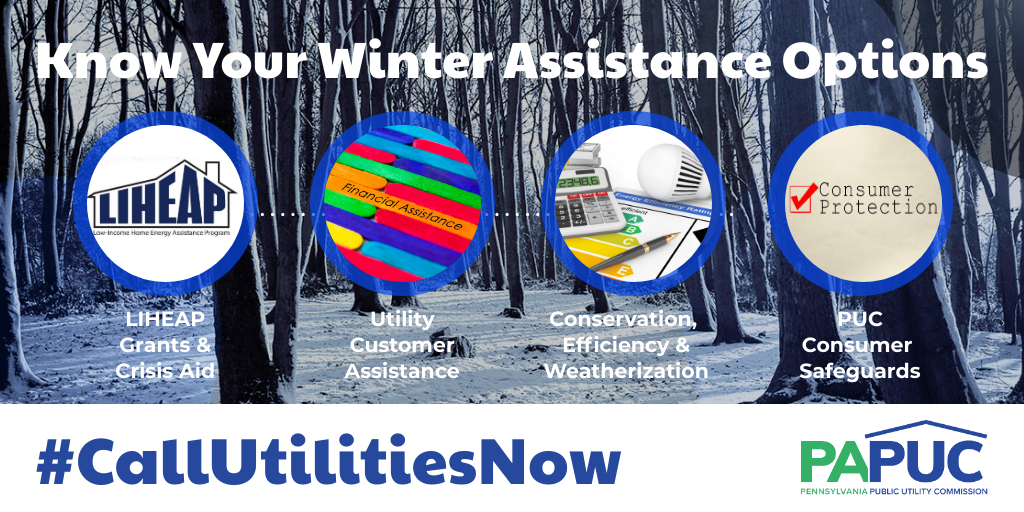As winter approaches and many utilities adjust their seasonal energy supply prices, the Pennsylvania Public Utility Commission (PUC) reminds consumers they have options to manage anticipated higher bills – and stresses that consumers currently struggling to pay monthly bills should act now and seek assistance by contacting their utilities.
As we approach the winter heating season, now is the time for consumers to consider ways to improve energy efficiency and conservation around their home or business, and #CallUtilitiesNow to explore utility assistance programs and discuss other ways to manage bills and stay connected.
Energy Costs
The cost of energy used each month – either electricity or natural gas – is the second key factor in the size of customer bills. It is important for consumers to understand the two major parts of their monthly electric or natural gas bills:
- Delivery/distribution charge – This charge includes the cost for the operation and maintenance of the poles, wires, pipelines, and other infrastructure that delivers energy to your home or business. This portion of your monthly bill supports your local utility.
- Generation/supply charge – This charge covers the cost of the energy (electricity or natural gas) used during the month. This energy cost for this portion of the bill is determined in two ways: one, by a consumer’s contract with a competitive supplier or two, for consumers who do not shop, the utility provides energy supply at the “Price to Compare” (PTC).
Electric – December 1 PTC Adjustments for Residential Customers
All Pennsylvania regulated electric utilities are adjusting their PTCs on December 1 for residential non-shopping customers. The PTC averages 40% to 60% of the customer’s total utility bill. However, this percent varies by utility and by the level of individual customer usage.
Beginning December 1, electric distribution companies report the following changes in their PTCs for residential customers:
- Citizens Electric, up from 9.3667 cents to 12.2259 cents per kWh (31%);
- Duquesne Light, estimated increase from 9.36 cents to 11.25 cents per kWh (20.2%);
- Met-Ed, up from 9.397 cents to 10.303 cents per kWh (10%);
- PECO, up from 8.508 cents to 9.855 cents per kWh (15.8%);
- Penelec, down from 10.021 cents to 9.889 cents per kWh (-1%);
- Penn Power, up from 10.348 cents to 10.511 cents per kWh (2%);
- Pike Co. Light & Power, Dec. 1 PTC not finalized – currently at 12.8994 cents per kWh;
- PPL, up from 12.366 cents to 14.612 cents per kWh (18%);
- UGI Electric, no PTC change on Dec. 1 from the current 12.903 cents per kWh;
- Wellsboro Electric, up from 9.592 cents to 12.816 cents per kWh (34%); and
- West Penn Power, up from 8.306 cents to 8.517 cents per kWh (3%).
The PUC notes that electric utilities are required to procure energy at the least possible cost. However, the Commission does not regulate prices for the generation portion of electric bills. Generation prices are separate from the closely regulated rates that utilities charge for their distribution services – the delivery of electricity to homes and businesses.
Natural Gas – PTC Changes for Residential Customers
Over the past few months, many of Pennsylvania’s natural gas distribution companies (NGDCs) have also adjusted their PTCs for non-shopping customers – and some NGDCs have seen increases in their purchased gas costs due to current energy market conditions. Similar to electric, the PTC averages 40% to 60% of the customer’s total utility bill, with the percentage varying by NGDC and by the level of individual customer usage.
The following NGDCs report PTC changes for residential customers:
- Columbia Gas of PA, up from $0.32613 to $0.7457 per therm (128%);
- National Fuel Gas, down from $0.9038 to $0.8778 per Ccf (-2.9%);
- PECO, down from $0.8346 to $0.8179 per Ccf (-2%);
- Peoples Natural Gas Co., down from $8.713 to $8.1342 per Mcf (-6.6%);
- Peoples Gas Co. LLC, down from $8.713 to $8.1342 per Mcf (-6.6%):
- Philadelphia Gas Works (PGW), down from $0.9381 to $0.8999 per Ccf (-4.2%):
- UGI Utilities, up from $0.85979 to $0.86063 per Ccf (1%); and
- Valley Energy, up from $0.41748 to $0.82047 per Ccf (96.5%).
Note: Changes in the purchased gas costs for PECO, PGW and UGI Utilities are anticipated on December 1. Any adjusted prices for those utilities will be available soon.
It is important to note that gas utilities are required to provide reliable natural gas service at the least possible cost. Every natural gas utility company is routinely audited by the PUC to ensure the Gas Cost Recovery they are passing on to their consumers reflects the costs the company paid and that every effort was made to purchase the natural gas for the least possible price.
#CallUtilitiesNow to Explore Customer Assistance Programs
The PUC continues to encourage struggling consumers to #CallUtilitiesNow, noting that direct conversations between struggling customers and utilities are the best “first step” in addressing outstanding bill balances and discussing utility assistance programs.
Public utilities are the first and most direct mechanisms to link struggling households with much-needed assistance. Utilities understand the assistance programs available in their communities for income-qualified consumers – including utility-run Customer Assistance Programs, national programs like the Low-Income Home Energy Assistance Program (LIHEAP), and various hardship fund programs operated by utilities and non-profit organizations.
#CallUtilitiesNow is the best way to identify what help may be available to you. Also, be sure to call all your utilities: electric, natural gas, water, wastewater, and telecommunications because each may have different programs or resources available.
Utilities also can help enroll consumers in assistance programs, guide them to other available resources and discuss new payment plan options to address overdue balances and help consumers move forward.
Managing Energy Usage
Energy usage is a key factor in the size of winter energy bills, and there are many ways that consumers can control that usage. Energy saving tips include:
- Pay attention to the thermostat – Every degree you raise or lower the temperature could impact energy costs by up to 3%. Also, consider a programmable thermostat to automatically lower temperatures while you are away from home.
- Have your furnace serviced – Regular furnace maintenance along with clean air filters help ensure efficient operation of your heating system.
- Insulate and seal leaks around your home – Adding insulation, installing storm windows and doors, and sealing cracks and air leaks can help you stay warmer and use less energy.
- Install or repair ceiling fans in high-trafficked rooms – Many people can reverse the direction of ceiling fans to clockwise to produce an updraft and move warmer air near the ceiling downward, keeping the room and you warmer.
- Consider resetting your water heater thermostat – Water heaters are the second highest source of energy usage in the home, and many people have the thermostat on their water heater set too high. Setting the temperature on your water heater a few degrees cooler can help save money on your energy bills.
The PUC’s electric shopping website PAPowerSwitch.com and natural gas shopping website PAGasSwitch.com have interactive sections with more easy consumer tips for saving energy.
LIHEAP
The Low Income Home Energy Assistance Program (LIHEAP) for the 2022-23 winter heating season opened on Nov. 1, 2022.
Pennsylvanians can apply for LIHEAP and other public assistance programs online at www.compass.state.pa.us or by phone at 1-866-550-4355. On-site County Assistance Office (CAO) services are available if clients cannot access online services or need assistance that cannot be accessed through the COMPASS website, the myCOMPASS PA mobile app, or by calling the Customer Service Centers at 215-560-7226 for Philadelphia clients or 1-877-395-8930 for clients in all other counties.
Understanding Your Electric Supplier’s Contract
Consumers who have contracts with competitive suppliers should make sure that they understand all terms and conditions contained in their supplier contract. The terms and conditions are found in the contract’s disclosure statement – including but not limited to the contract’s expiration date and any terms and conditions for terminating a contract.
Consumers who signed up with competitive energy suppliers last winter – perhaps for the first time – could be approaching the end of those contracts. It is important to understand your options at the end of a contract, as well as the importance of taking action to avoid any surprising changes in energy prices.
Consumers that already have an agreement with an electric supplier and want to switch to a different supplier, or return to default service with their electric utility, should carefully review their contract’s disclosure statement to see if there are any penalty/switching fees or cancellation fees. Call your current supplier if you are not sure.
Additionally, consumers should be aware that at the end of a supplier’s contract, they will receive two contract renewal notices: an Initial Notice 45-60 days prior to the contract’s expiration date; and then an Options Notice at least 30 days prior to the end of the contract.
After receiving a second contract renewal notice, consumers should not stay silent and make sure to choose one of the options mentioned in the notice. If a customer fails to respond with one of these options, they may automatically remain with the current supplier on a month-to-month basis without any early termination fees.
Customers who have questions about the end of their contract should contact their current supplier and, if there is a problem, then contact the PUC’s Bureau of Consumer Services at 1-800-692-7380. More information on understanding a contract with an electric generation supplier and electric switching can be found here on PAPowerSwitch.com.





